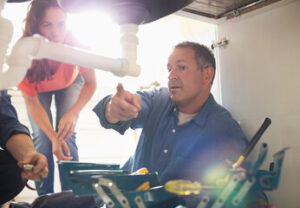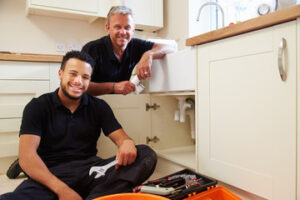Plumbers Woodbridge NJ install, repair, and maintain a wide variety of plumbing systems. They may work in residential, commercial, or industrial settings. Plumbers usually need to interpret building codes and blueprints in order to properly place piping and fixtures.

Interacting with clients is common for plumbers, as they often explain issues and provide estimates for their services. This can require strong customer service skills.
Battery backup systems work alongside the primary sump pump in the sump basin, but they are powered by a battery rather than electricity. When the main sump pump fails due to a power outage or a blockage, the battery backup system kicks in and drains away the water. This can keep the basement from flooding during a severe storm or blackout.
Plumbers can install the system along with your existing sump pump, and it’s usually less expensive than an entirely new pump. It also requires less maintenance, as there is no electrical component that can fail.
The plumbers at Hy-Pro Plumbing can help you choose the best battery backup option for your home. They can explain the difference between different models, so you can pick one that fits your budget and needs. They can also show you how to maintain your system. Ensure that the batteries are kept in an area with moderate temperatures and are properly protected against extreme heat or cold. Also, make sure the batteries are plugged into a GFCI outlet that is above the highest water line and that the outlets are tested annually.
Check Valve
A check valve is an option for your sump pump installation that can prevent backflow and reduce the risk of water hammer. They are commonly used in sewage pumps and bilge pumps, but they also serve to keep the water in swimming pools flowing to the bottom of the pool instead of back up into the drains, toilets, or the atmosphere. These valves come in many sizes, designs and materials to ensure that there is a suitable option for your specific application.
Essentially, check valves are two-port valves with an opening for the media to enter and an opening for the media to exit. The valve is controlled automatically and usually does not have a stem or handle. They have a disc or diaphragm that sits in a seat and seals shut when the flow is reversed. The disc can be lifted by higher pressure from upstream, which allows flow to pass through the valve, but gravity or lower backpressure will cause the valve to reseat.
Check valves are designed to resist the buildup of backpressure that causes water hammer by closing quickly. This helps to reduce the shock waves that are created as the disc slams into the seat of the valve. This will reduce the likelihood of the elastomers and seat becoming worn, as well as leaking from the valve.
Sanitary check valves are a type of check valve that is made to meet sanitation requirements, including being easy to clean and sterilize. They should be constructed from non-porous materials and must feature no rough edges or crevices to prevent bacteria or other organisms from gaining a foothold inside the valve. The valve should also be made to allow for a clean-in-place procedure, which allows the valve to be cleaned without having to remove it from the pipeline.
Some types of sanitary check valves, such as the spring-loaded in-line model, have a simple design and are inexpensive to maintain. Other models, such as the lift check valve and the duckbill check valve, are made from rubber or other synthetic elastomers and are more costly to repair.
Drainage Pipe
Drainage pipes are designed to transport all of the collected wastewater from your house, including bathroom and kitchen sinks, shower lines, toilets and water closets, to the main sewer line outside. There are several different drainage pipe options, depending on the material and the size. The type of pipe you choose is important because it will influence how durable the pipe will be and its expected lifespan.
In general, the most durable and cost-effective drainage pipes are made of polyvinyl chloride (PVC) or acrylonitrile butadiene styrene (ABS). These types of pipes are strong enough to withstand the weight of soil and water and resist corrosion from harsh chemicals. In addition, these pipes are safe for use in most environments and can easily be joined with a variety of fittings.
Another option for drainage pipe is cross-linked polyethylene, or XPE. This is a more expensive but durable option for home drainage pipes, especially in colder climates. Unlike PVC, XPE can withstand freezing temperatures and is resistant to corrosion from acidic solutions. It is also more durable than cast iron and can be used in groundwater applications.
Most homes also have a drain trap, also called a P-trap, which is a curved segment of plumbing that sits below each fixture drain. The purpose of the drain trap is to prevent sewer gases from entering the home. It can be made of various materials, but most plumbers prefer to use clay or cast iron.
The last type of drain pipe that most plumbers will use is concrete. This type of pipe is typically reserved for larger underground drainage and sewer lines and has an expected lifetime of 50 to 100 years. In some cases, a plumber may also need to install an in-ground sump pump. This is an efficient way to keep stormwater from pooling around a foundation and damaging the building’s structure over time.
For a sump pump installation, the discharge pipe should be at least a foot away from the home’s foundation to avoid flooding and damage. It should be buried in a shallow trench and graded to drain away from the house. The pipe should also have a downward pitch so that it will not be susceptible to frost cycles or the movement of soil.
Sump Basin
A sump basin, sometimes called a “sump pit,” is a hole that’s dug in the basement or crawl space to collect excess moisture. If the moisture builds up and is not pumped out, it can damage the walls and foundation of your home. A plumber will install a sump basin and a pump, as well as connect a discharge pipe to the basin and run it outside.
During installation, the plumber will mark the circle where the basin liner will go on the floor using a permanent marker. Then, he or she will dig out the concrete in that area to the depth of the basin liner. This step can take a lot of work and may require renting a jackhammer. The plumber will then install the basin liner and backfill the area around it with gravel.
In older installations, the sump pumps may discharge into a sanitary sewer. This is against the law in many municipalities, as it can overwhelm sewage treatment facilities. If this is the case in your home, you’ll need a plumber to disconnect and reroute the sump pit drainage to an outdoor dry well or the soil.
Once the pipes are connected, the plumber will plug in the pump and test it. To do so, pour a bucket of water into the basin. If the float rises, the pump will turn on and pump the water out. The plumber will then inspect the basin, pump, and pipes to make sure they’re all working correctly.
The plumber can add other accessories to the sump pump, including a battery-powered water alarm that’s hung a short distance below the top of the basin to sound an alarm if the water level gets too high. There are also remote monitoring systems that will alert you via a telephone or cell phone connection to a central monitoring center if your pump becomes clogged with debris or fails in some way.
A sump pump is a great addition to any home, but it must be properly installed by a plumber to avoid costly flood damages. If you’re considering a sump pump, ask your plumber for a free estimate.

